We will be outlining the Ryzen 7 1700 CPU's performance while using an ASUS Crosshair VI Hero AM4 motherboard.
A 16GB (2x8GB) kit of G.Skill's Trident Z DDR4 memory serves our test system. The kit's rated frequency of 3200MHz with CL14 timings should ensure that memory-induced bottlenecks are removed. A strength for the ASUS board is its ability to run this memory at 3200MHz CL14, which is pushing on the limit of memory speed capability for the AM4 platform.
Today's comparison processors come in the form of:
- Piledriver FX-8370.
- Sandy Bridge i7-2700K.
- Ivy Bridge i5-3570K.
- Devil's Canyon i7-4790K (Haswell-based).
- Haswell-E i7-5960X.
- Broadwell-E i7-6800K and i7-6950X.
- Skylake's i5-6600K and i7-6700K.
- Kaby Lake's i3-7350K, i5-7600K, and i7-7700K.
- Ryzen 7 1700X and 1800X.
These form some of the best and most popular CPUs in their respective pricing ranges and product hierarchies for this generation and past ones. They also give a solid overview of where the Ryzen 7 1700X slots into the current market in terms of performance.
We went out and paid over £1,500 (!) to buy a Core i7-6950X 10C20T CPU in order to compare Ryzen 7 offerings to the current fastest consumer processor on the market. Our trusty old Haswell-E Core i7-5960X serves as the 8C16T competitor for Intel's HEDT platform as we do not have access to the Broadwell-E i7-6900K (which is very similar in performance).
The Ryzen 7 1700 sat comfortably at its 3.2GHz all-core boost frequency throughout testing thanks to our strong Noctua D15 CPU cooler and solid power delivery from the ASUS motherboard. XFR was confirmed as operating at 3.75GHz by running multiple different single-threaded workloads and checking the real-time clock speed.
We test Intel CPUs using the forced turbo (multi-core turbo – MCT) setting that most motherboard vendors now enable by default or when using XMP memory. This feature pins all of the CPU's cores at the maximum turbo boost frequency all of the time. The voltage is bumped up to enhance stability but this results in greater power consumption and higher temperature readings which are important to remember when testing those parameters.
We also tested all CPUs' achievable overclocked frequencies so that you can see how your overclocked chip compares to another stock or overclocked chip.
CPU Test System Common Components:
- Graphics Card: Nvidia GeForce GTX Titan X Pascal (custom fan curve to eliminate thermal throttling).
- CPU Cooler: Noctua NH-D14 / Noctua NH-D15 / Cryorig R1 Ultimate / Corsair H100i v2 / Corsair H110i GT / EKWB Predator 240.
- Games SSD: SK hynix SE3010 SATA 6Gbps 960GB.
- Power Supply: Seasonic Platinum 1000W / Seasonic Platinum 760W.
- Operating System: Windows 10 Pro 64-bit (Anniversary Update).
We use a mixture of high-end air and AIO coolers to gather performance measurements without thermal throttling playing a part. Seasonic's Platinum-rated PSUs provide ample power to really push the CPU overclocks. Nvidia's GTX Titan X Pascal is the fastest gaming GPU on the planet, making it ideal for alleviating GPU-induced bottlenecks and putting the onus on CPU performance.
While we use a mixture of cooling and PSU hardware for general testing, where it is important to keep those items identical (power draw and temperature readings) we ensure that the correct hardware is used to deliver accurate data.
Ryzen AM4 System (Ryzen 7 1800X, Ryzen 7 1700X):
- 1800X CPU: AMD Ryzen 7 1800X ‘Summit Ridge' 8 cores, 16 threads (3.6-4.0GHz stock w/ 4.1GHz XFR & 4.1GHz @ 1.43125V overclocked).
- 1700X CPU: AMD Ryzen 7 1700X ‘Summit Ridge' 8 cores, 16 threads (3.4-3.8GHz stock w/ 3.9GHz XFR & 4.0GHz @ 1.41875V overclocked).
- 1700 CPU: AMD Ryzen 7 1700 ‘Summit Ridge' 8 cores, 16 threads (3.0-3.7GHz stock w/ 3.75GHz XFR & 4.0GHz @ 1.41875V overclocked).
- Motherboard: ASUS Crosshair VI Hero (AM4, X370).
- Memory: 16GB (2x8GB) G.Skill Trident Z 3200MHz 14-14-14-34 DDR4 @ 1.35V.
- System Drive: Crucial MX300 525GB.
Kaby Lake & Skylake LGA 1151 System (7600K, 7700K, 6600K, 6700K):
- 7600K CPU: Intel Core i5-7600K ‘Skylake' (Retail) 4 cores, 4 threads (4.2GHz stock MCT & 4.9GHz @ 1.35V overclocked).
- 7700K CPU: Intel Core i7-7700K ‘Skylake' (Retail) 4 cores, 8 threads (4.5GHz stock MCT & 4.8GHz @ 1.35V overclocked).
- 6600K CPU: Intel Core i5-6600K ‘Skylake' (Retail) 4 cores, 4 threads (3.9GHz stock MCT & 4.5GHz @ 1.35V overclocked).
- 6700K CPU: Intel Core i7-6700K ‘Skylake' (Retail) 4 cores, 8 threads (4.2GHz stock MCT & 4.7GHz @ 1.375V overclocked).
- Motherboard: MSI Z270 Gaming Pro Carbon & Gigabyte Aorus Z270X-Gaming 7 (LGA 1151, Z270).
- Memory: 16GB (2x8GB) G.Skill Trident Z 3200MHz 14-14-14-34 DDR4 @ 1.35V.
- System Drive: Samsung 840 500GB.
Broadwell-E & Haswell-E LGA 2011-3 System (5960X, 6800K, 6950X):
- 5960X CPU: Intel Core i7 5960X ‘Haswell-E' (Engineering Sample) 8 cores, 16 threads (3.5GHz stock MCT & 4.4GHz @ 1.30V overclocked).
- 6800K CPU: Intel Core i7 6800K ‘Broadwell-E' (Retail) 6 cores, 12 threads (3.6GHz stock MCT & 4.2GHz @ 1.275V overclocked).
- 6950X CPU: Intel Core i7 6950X ‘Broadwell-E' (Retail) 10 cores, 20 threads (3.5GHz stock MCT & 4.2GHz @ 1.275V overclocked).
- Motherboard: ASUS X99-Deluxe (LGA 2011-v3, X99).
- Memory: 32GB (4x8GB) G.Skill Trident Z 3200MHz 14-14-14-34 DDR4 @ 1.35V.
- System Drive: SanDisk Ultra Plus 256GB.
Devil's Canyon LGA 1150 System (4790K):
- 4790K CPU: Intel Core i7 4790K ‘Devil's Canyon' (Engineering Sample) 4 cores, 8 threads (4.4GHz stock MCT & 4.7GHz @ 1.30V overclocked).
- Motherboard: ASRock Z97 OC Formula (LGA 1150, Z97).
- Memory: 16GB (2x8GB) G.Skill Trident X 2400MHz 10-12-12-31 DDR3 @ 1.65V.
- System Drive: Kingston SM2280S3/120G 120GB.
Sandy Bridge & Ivy Bridge LGA 1155 System (2700K, 3570K):
- 2700K CPU: Intel Core i7 2700K ‘Sandy Bridge‘ (Retail) 4 cores, 8 threads (3.9GHz stock MCT & 4.6GHz @ 1.325V overclocked).
- 3570K CPU: Intel Core i5 3570K ‘Ivy Bridge' (Retail) 4 cores, 4 threads (3.8GHz stock MCT & 4.6GHz @ 1.30V overclocked).
- Motherboard: ASUS P8Z77-V (LGA 1155, Z77).
- Memory: 16GB (2x8GB) G.Skill Trident X 2400MHz 10-12-12-31 DDR3 @ 1.65V (@2133MHz for 2700K due to CPU IMC limitation).
- System Drive: Kingston HyperX 3K 120GB.
Vishera AM3+ System (FX-8370):
- FX-8370 CPU: AMD FX-8370 ‘Vishera' (Retail) 8 cores, 8 threads (4.0-4.3GHz stock & 4.62GHz @ 1.45V CPU, 2.6GHz @ 1.30V NB overclocked).
- Motherboard: Gigabyte 990FX-Gaming (AM3+, SB950).
- Memory: 16GB (2x8GB) G.Skill Trident X 2133MHz 12-12-12-31 DDR3 @ 1.65V.
- System Drive: Patriot Wildfire 240GB.
Software:
- ASUS Crosshair VI Hero BIOS v5704 (pre-release).
- GeForce 378.49 VGA drivers.
Tests:
Productivity-related:
- Cinebench R15 – All-core & single-core CPU benchmark (CPU)
- HandBrake 0.10.5 – Convert 6.27GB 4K video recording using the Normal Profile setting and MP4 container (CPU)
- Mozilla Kraken – Browser-based JavaScript benchmark (CPU)
- x265 Benchmark – 1080p H.265/HEVC encoding benchmark (CPU)
- WPrime – 1024M test, thread count set to the CPU's maximum number (CPU)
- SiSoft Sandra 2016 SP1 – Processor arithmetic, cryptography, and memory bandwidth (CPU & Memory)
- 7-Zip 16.04 – Built-in 7-Zip benchmark test (CPU & Memory)
Gaming-related:
- 3DMark Fire Strike v1.1 – Fire Strike (1080p) test (Gaming)
- 3DMark Time Spy – Time Spy (DX12) test (Gaming)
- VRMark – Orange room (2264×1348) test (Gaming)
- Ashes of the Singularity – Built-in benchmark tool CPU-Focused test, 1920 x 1080, Extreme quality preset, DX12 version (Gaming)
- Gears of War 4 – Built-in benchmark tool, 1920 x 1080, Ultra quality preset, Async Compute Enabled, DX12 (Gaming)
- Grand Theft Auto V – Built-in benchmark tool, 1920 x 1080, Maximum quality settings, Maximum Advanced Graphics, DX11 (Gaming)
- Metro: Last Light Redux – Built-in benchmark tool, 1920 x 1080, Very High quality settings, SSAA Enabled, AF 16X, High Tessellation, DX11 (Gaming)
- Rise of the Tomb Raider – Built-in benchmark tool, 1920 x 1080, Very High quality preset, SMAA enabled, DX12 version (Gaming)
- The Witcher 3: Wild Hunt – Custom benchmark run in a heavily populated town area, 1920 x 1080, Maximum quality settings, Nvidia features disabled, DX11 (Gaming)
- Total War Warhammer – Built-in benchmark tool, 1920 x 1080, Ultra quality preset, DX12 version (Gaming)
 KitGuru KitGuru.net – Tech News | Hardware News | Hardware Reviews | IOS | Mobile | Gaming | Graphics Cards
KitGuru KitGuru.net – Tech News | Hardware News | Hardware Reviews | IOS | Mobile | Gaming | Graphics Cards


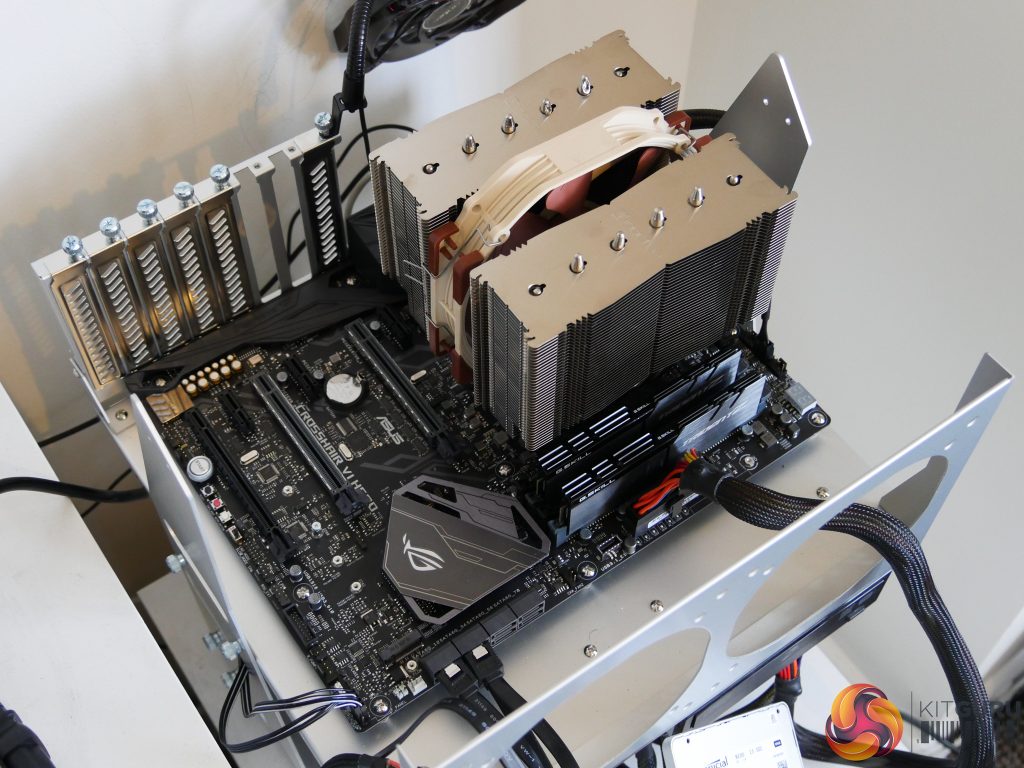
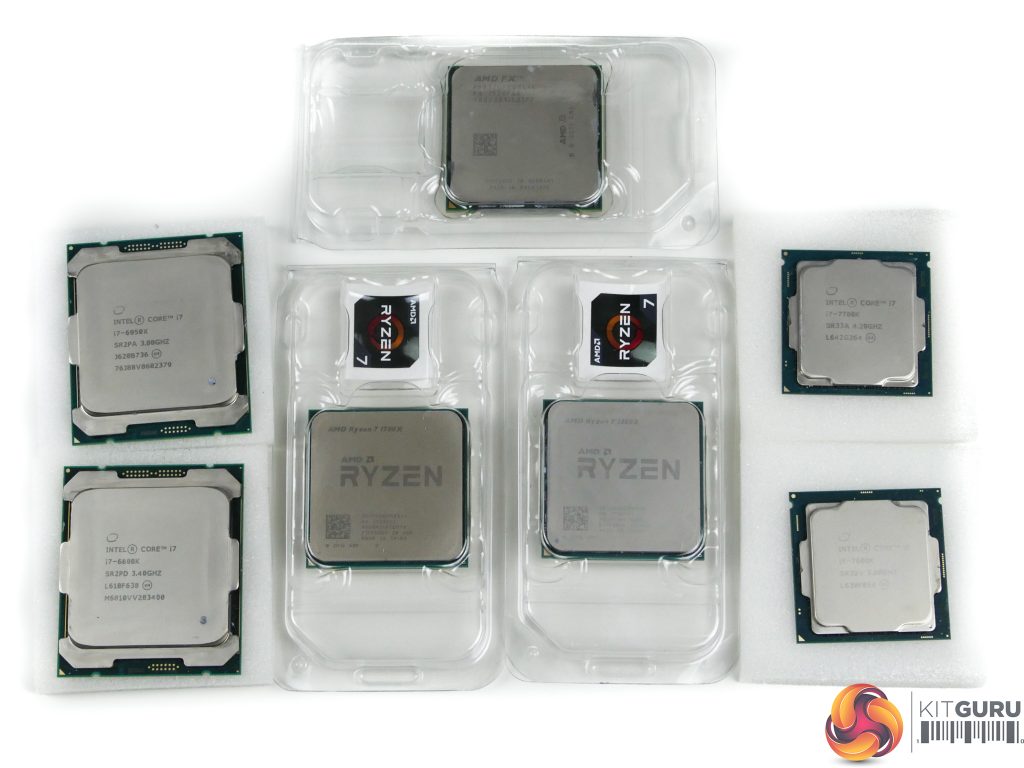
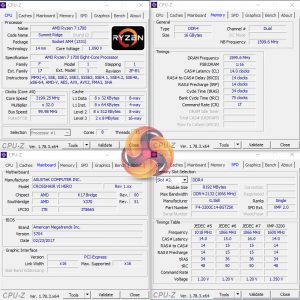
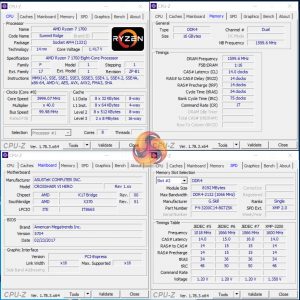
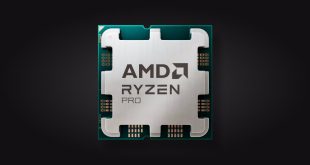
I was under the impression that XFR was only included on the X chips, yet you wrote that it is available on the 1700. Was this a mistake or is XFR actually enabled on the 1700 contrary to what I’ve read pretty much everywhere else?
XFR is enabled but only at half the headroom. The current X chips get 100MHz of XFR headroom whereas this non-X chip gets 50MHz. We validated this with multiple single-threaded tests and watched the frequency in CPUID HWMonitor report as 3750MHz on the loaded cores.
Interesting. I didn’t know that was a thing. Thanks!
Next gripe. Page 3 has the Ryzens listed at Summit Ridge, which isn’t their code name. The code name was Zen. Summit Ridge refers to the Zen based APUs that AMD has yet to release.
Thanks for the info. I’ve been following closely but I was completely unaware that the 1700 had XFR.
Good review, so in summary, if you want to play your games at very low resolutions, with refresh rates that your monitor does not support get the i7-7700k . But if you want a real PC that can do all other workstation tasks, and game at high resolution, get the Ryzen 1700. Anyhow, I don’t think anymore will buy a high end GPU and play in low res. What we need is a Real World comparison between the AMD and Intel chips. Can you do one for us please?
The 1700 is an impressive cpu. I can’t deny that it will do better in games once developers begin optimizing. I have mine sitting in the MSI Carbon Pro and is happily running at 4.0ghz 24/7 at 1.3875vcore. However try as I might I am not able to get my 3200 ram above 3000 at the moment. MSI have not been quick to produce new bios revisions and to date only have the one bios listed on their website!!!
There are 4K gaming tests in there also, which show very little difference between the Intel and AMD chips due to such demand being placed on the GPU. As for high refresh rate gaming, almost half of our readers like to game at 100 FPS or above: http://www.kitguru.net/tech-news/featured-announcement/matthew-wilson/kitguru-poll-shows-49-3-percent-of-readers-prefer-gaming-at-100hz-and-above/
This review is done so well except you don’t even have a 6900k!
wow I hate the smooth scrolling on your website, it’s the worst thing ever invented.
What your readers say and what they do is very different. Not that many people actually have >60hz monitors.
So my 1700 hits 3.75Ghz on all cores at 1.225v, is that a good result? I’ve only ever overclocked on intel’s x79 and x99 platform so I’m a bit clueless when it comes to AMD. Rock solid stable for 5 hours, even on the stock cooler didn’t see temps over 70C.
Any help haha?
I agree that monitors with refresh rates higher than 60Hz are less common. But we cannot ignore the fact that almost half of our readers are also interested in performance relating to higher refresh-rate gaming.
Either way, 1080P and 4K data are both in the review. If a reader is not interested in high refresh rate gaming, then checking that the CPU of interest can handle 60 FPS in the relevant game should be a sufficient interpretation of the results.
I would say that is a pretty good overclock. You could probably push the frequency around 150-250MHz higher but that will require a voltage increase and better cooler. The power draw and temperatures at 1.225V should be fine for long-term use. If that’s stable enough for your needs, I’d be inclined to stick with that balance of frequency and voltage, personally. But if you need more performance you may be able to push frequency a little higher with increased voltage.
I honestly can’t believe anyone would like to game at 100 FPS or above at Ultra Low Quality. Its like saying, that your readers also prefer to watch a block buster movie on their smart phones, instead of going to the cinemas. Anyhow, as you have mentioned there is no difference in gaming in the real world, the Ryzen wins easily when it comes to all other workstation use. The choice here is a no brainier.
That’s subjective. Each to their own preference. High refresh rate gaming doesn’t have to be low quality (resolution) either – there are 2560×1440 and 3440×1440 100Hz+ monitors on the market and 100Hz+ 4K monitors coming out this year. There are people using high refresh rate monitors so we can’t just ignore that fact. If it isn’t of importance to your usage scenarios, the performance on offer may be ideal for you.
I`m very curious what motherboard are you using to achieve that OC?
From what you are saying, I honestly can’t fandom why anyone would buy a 4K monitor with high refresh rate, then downscale it to 1080p, and buy high end gaming PC hardware just to play at high FPS at 1080p. Like I said, we need to focus on the real world tests here, not some unrealistic scenario. In the real world, people do more with their CPU than just gaming, many people multi-task while gaming. It would be very beneficial to do a multi-tasking gaming benchmark to see if the extra cores of Ryzen are really useful in the real world or not. A typical example would be streaming and gaming, do the extra cores help make Ryzen a better real world gaming PC?
But aren’t high refresh rates the domain of the GPU? How does a CPU affect refresh rates?
Check this out, there’s a YouTube Channel called “Game Testing” that pits different CPUs against each other and also different GPUs against each other and shows them in split-screen mode in real-time. On the left side of the screen you have one contender and on the right side you have the other contender both running at the same time.
I think that these are really creatively done (and I didn’t do them) and they really do show the difference (especially the lack thereof) in gaming between the Summit Ridge (R7-1700) and Kaby Lake (i5-7600K) architectures. Both CPUs are at stock clocks, the resolution is demonstrated to be 1080p and an nVidia GeForce GTX 1070 to ensure that there are no GPU bottlenecks. Enjoy!
We’ll start with a video that pits the R7-1700 against the i5-7600K in seven modern titles. Those titles are Project Cars, Arma III Apex, Fallout 4, Rise of the Tomb Raider, Hitman 2016, Just Cause 3 and Far Cry Primal.
https://www.youtube.com/watch?v=RBbJtOPUVcU
Now to add more like Grand Theft Auto V:
https://www.youtube.com/watch?v=UFffMS6m2vg
The Witcher 3:
https://www.youtube.com/watch?v=TXOHmZEQmAc
Crysis 3:
https://www.youtube.com/watch?v=piNUGg3pejA
Need For Speed 2015:
https://www.youtube.com/watch?v=y57Beci-vf0
Far Cry 4:
https://www.youtube.com/watch?v=jJ4Mi62bvkA
Watchdogs 2:
https://www.youtube.com/watch?v=rNq2hPMrmTw
And Battlefield 4:
https://www.youtube.com/watch?v=vgLNFpgFOl4&t=48s
So there’s fourteen games, all played at 1080p with a GTX 1070 with one side of the screen using an R7-1700 and the other side using an i5-7600K. I hope that this helps give a real and meaningful demonstration, far better than any benchmark bars ever could. I didn’t make these videos but they are the best thing I’ve ever seen for demonstrating real gameplay experience between Summit Ridge and Kaby Lake. Their channel has a whole bunch of other videos including videos saying that I don’t even need to upgrade my old FX-8350 for gaming just yet!
How do you like those benchmarks now? LOL
The CPU needs to prepare the data for the GPU. The faster the GPU requests that data, the faster the CPU needs to prepare it. That’s why high refresh rate gaming puts additional onus on CPU performance whereas 60 FPS gaming is generally comfortable for modern CPUs of this calibre (if the GPU is sufficiently fast).
That’s great, thanks for the benchmarks, as you said it gives a true picture of what is going on, much better than any graphs. So there is no real world difference between the game plays, i can’t tell the difference between 200 and 210 fps lol.
when i removed my cpu some accidental thermal paste went inside the pins. is it okay?
It’s not conductive but could cause a problem later making the joint between the pins capacitive in nature later on down the road as it dries somewhat. That’s a problem don’t risk it.
Make sure when you do this below that the alcohol level IS NOT higher then just to soak pins
and barely contacting the base. You don’t throw it in and submerge it. Use some common sense here.
And it will be fine.
So:
• Take a disposable bowl.
• Take 90% or higher isopropyl alcohol.
• Pour about one cup of alcohol into the bowl.
• Place chip pin side down into bowl.
• Let soak for about 5 – 10 minutes.
• Wait.
• Order a Pizza.
• Take a toothbrush, preferably a soft bristled one and dip that into the alcohol also.
• Softly and I mean softly brush in between the pins till all the thermal grease is removed.
• Let CPU dry on either a lintless towel or a paper towel till the alcohol is evaporated.
• Drink the remaining alcohol. Both in the bowl and in the bottle. It’ll put hair on your chest.
• Throw the bowl away. In a recycling bin. Good for the planet.
• Eat Pizza, remembering to wash your hands before returning to work.
• Replace CPU in socket, then reapply AS5.
ty
You can really see how the ryzen 7 line up is binned. 1800x better idle than 1700x -> better than 1700.
Intel: Anti-Competitive, Anti-Consumer, Anti-Technology.
https://www.youtube.com/watch?v=osSMJRyxG0k